This article is part of my ongoing “Indie Fighting Game Thursday” review/retrospective series, now on supercombo.gg! This week we talk about Mega Knockdown, a turn-based, grid-based fighting game which takes something unique to the table. The game is still in a VERY early alpha, with just a closed build, so be aware that things may change quite soon!
Turn based grid action
If some of you watched one of the most recent videos by Stumblebee about creativity in indie fighting games, you might have caught wind of a quirky, work-in progress game, which played on a grid, with digitized actors placeholder graphics. At that point of the video, you might have asked yourself “what is this game”? Well, fret not, my fellow indie fighting game connoisseur, because this Thursday I’m taking you for a ride in the bizarre world of Mega Knockndown, a turn-based fighting game developed by the small studio Mega Memecast!
If the idea of a turn-based fighting game sounds somewhat strange to you, I’d like to point out that it’s something flying around the industry for years already. Just to cite the most illustrious case, it surfaced that former Capcom producer Yoshinori Ono originally wanted Street Fighter 4 to be a turn-based game, as he confirmed during a live interview at EGX 2019. Aside from this famous precedent, and nearer to the indie area, there have also been attempts to turn fighting games into card games, with Sirlin Games’s Yomi and Goldrick Games’s Versus Tag Shuffle (this last one still in progress).
Driven by the will of seeing for myself how this idea could play in practice, I have reached out for the developer Mega Memecast and was given a Steam alpha key for the current version of the game. So, brace yourself, turn your grey cells on and get ready for the ultimate “read your opponent” simulator!
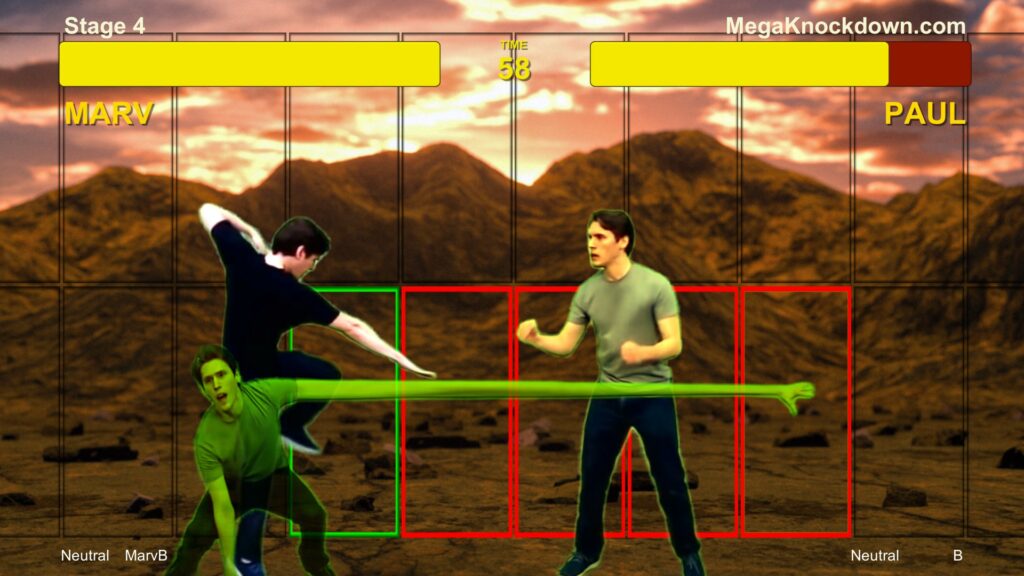
Who could have ever thought of using Jerma’s green screen clips for a fighting game? Well, the developers at Mega Memecast did, and the result is glorious, albeit as placeholders!
A Jerma fighter?!
Before we begin with the mechanics, I need to get this point straight: I am not a very assiduous Twitch denizen. Until I have started researching this game for this article, I didn’t even know who Jerma was. What I know, though, is that he published a collection of handy green screen clips, that some diligent fan of his put together in a playlist. For those who don’t know what is a green screen/chroma key technique, here’s how it works: you record a movie clip on a bright, flat-colored surface (usually blue or green), so that the background of the clip can be removed digitally later, in a rather elegant and straightforward fashion. This technique is used in cinematography to overlay different scenes together or add actors on top of your CGI backgrounds. If you want a recent example of (over)use of this technique, look no farther than the MCU movies.
Off-topic aside, the net end result is that the developers of Mega Knockdown made an intelligent use of the Jerma green screen clips and used them to build six basic working move sets, one per each character. The end effect is actually glorious, in a sort of “early Mortal Kombat” fashion, even if I know that this is just a placeholder. If Jermas are not of your liking, there is also an option to switch from his digitized pictures to colored silhouettes (that are basically flat recolors of the sprites). The developer told me that they are still unsure about the art direction of the finished game, but for a prototype it’s actually good enough.
But enough with the introductory banter and let’s delve a bit more in how this game works!
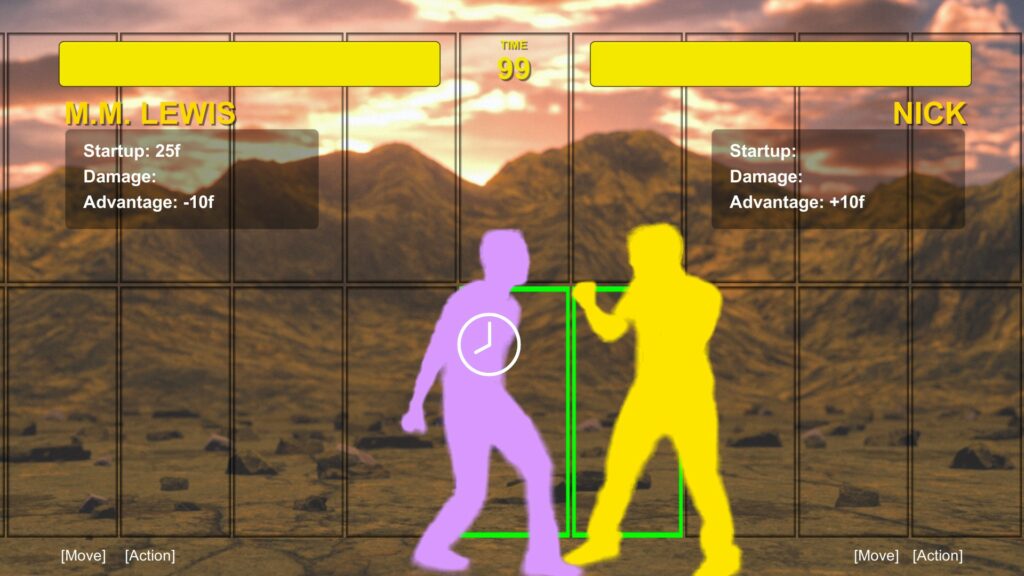
Training mode shows the usual fighting game basic information, like startup, frame advantage, hitboxes and hurtboxes… except that everything is turn-based! Also, you might have noticed the colored silhouettes here instead of the Jerma cutouts. That’s because the current alpha offers a toggle to switch between the two temporary art styles.
My turn!
Mega Knockdown is a simultaneous turn based fighting game. Each turn, both players need to input their actions, which will play at the same time as soon a the new turn start. Each action consists in one direction and one input button. There are three attack buttons, a block button and a grab button, that can be combined together with the directional button to perform several possible basic actions:
- to move without attacking, one can press forward or backwards plus block. This action will block every attack except grabs and sweep;
- to block while standing, one needs to press down and block. This is the only way to block a sweep, except from jumping, as there is no crouching;
- pressing up and block will result in jumping backwards;
- pressing up and any attack button will result in a jump attack or an air grab;
- you can’t jump forward and block or “safe jump: you always need to input an action while jumping and the character will always move forward while doing so;
- pressing down and an attack button will perform that attack in place. Pressing a direction together with the attack button will instead perform the attack after the character has moved forward or backward;
- grabs can be teched with the grab button, but command grabs must be jumped over;
- some button combinations (e.g. forward plus heavy attack) result in different special moves, depending on the character.
So far, so simple, right? There is a catch, however: the startup of each move is influenced by the frame advantage achieved during the previous turn, essentially “summing up” and determining the outcome of the clash by taking it into account. Moreover, some moves are so unsafe on block that, upon blocking them, the opponent will get a free turn to punish your hubris.
Notice that when you are knocked down, for example by a grab or a sweep, every command you input will lose its directional properties, making it more difficult for you to get out of your opponent’s pressure.
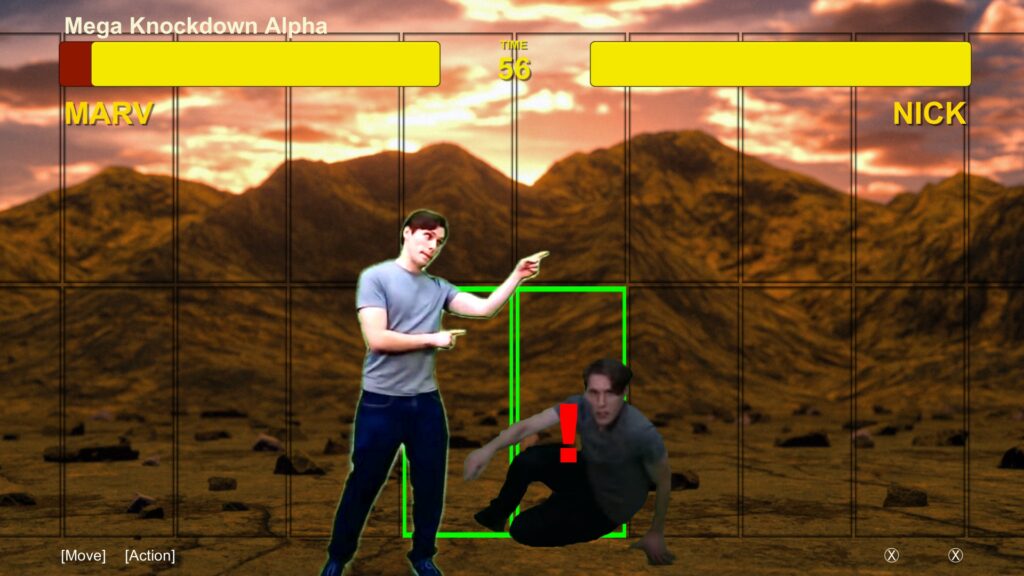
“And that’s when Nick realized that if you try to sweep too often in neutral, Marv will take you for a ride.”
Win neutral and profit
This game doesn’t really have manual combos. If you win an interaction, either with an anti-air or a normal move that is not a sweep, your character will perform a short, pre-determined sequence of attacks that deals significant damage to the opponent. Trades do not trigger any combo and special moves are currently single-hit moves. Some of them deal a tremendous amount of damage (e.g. Big Billy Buster and Pile Debunker), but most of them are more thought as utility moves, zoning tools or reversals.
Knocking down the opponent puts them in a very dangerous blender, as they lose all their movement options and are forced to commit to a grab break, block, a delayed attack button or jump to try and get out of a sticky situation. The difference with a normal fighting game is that here you have all time in the world to think about your situation, and there aren’t any execution barriers: if your opponent has consistently the best of you, it means that you have been sorely outplayed.
This is actually a selling point of the game in my opinion: you can’t fumble the inputs, you aren’t influenced by dexterity, reactions and reflexes — if you make a bad decision, you have to leave with the results of it. Mega Knockdown might actually be one of the best tools to improve decision making in standard fighting games. I welcome this bold game design idea, and I think it could be extremely interesting to see its application in the future as e.g. a training mode option in a traditional 2D fighting game.
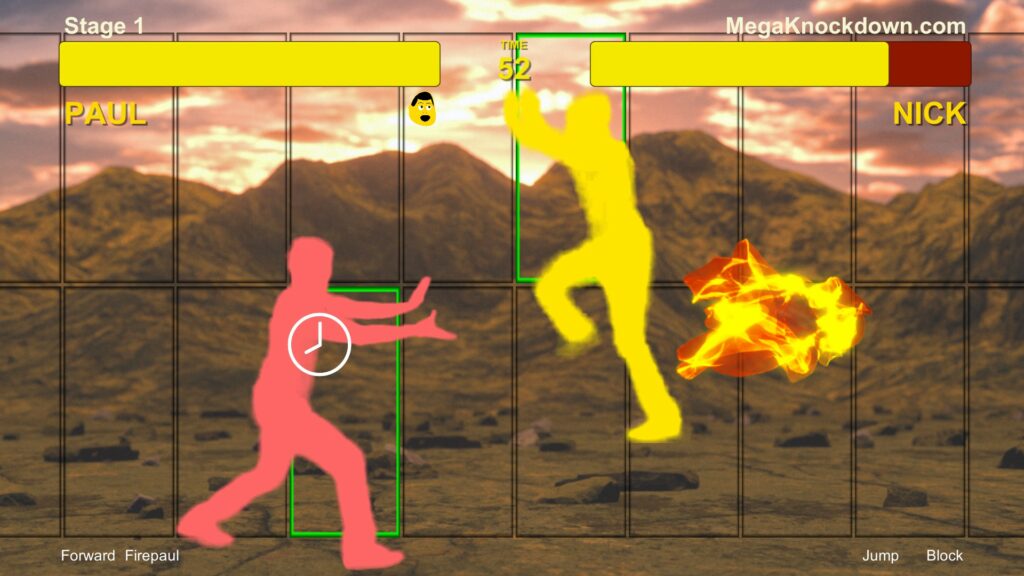
Whiffing a special move will leave you in a very precarious and dangerous situation. A clock icon will pop up to let you know that you have a significant frame disadvantage
FIREPAUL!
Special moves are performed by inputting specific button combinations (e.g. forward plus heavy attack), which means that the corresponding normal move is shut down. This creates an interesting balance: by barring access to one or two standard normals, characters can lose options that would change their gameplan significantly, For a practical example, Marv — the assist Dhalsim function of this game — has an anti air kick with high vertical reach mapped to Neutral Light Attack, which replaces his standing jab. This means that in exchange for a good anti-air move, Marv loses access to the fastest normal move in the game, forcing a Marv player to take more risks to maintain the correct spacing. It’s a clever idea and adds quite a lot to the overall feeling.
Six character archetypes
The current alpha offeatures six Jerma palette swaps/colored silhouettes with different backgrounds and properties. The art is temporary and will be replaced in the future, but the core gameplay is already well defined. Each character has active and passive skills that change the way they are played on a fundamental level. Paul is the typical shoto function, with an invincible reversal and a full screen fireball; M. M. Lewis is an evasive character whose entire gameplan is based on “reading” the opponent, dodging and counter attacking with his evasive “dandy step” like moves. Lewis has also the passive trait “allergic to block” that makes him receive chip damage from normal moves too; Billy is the powerhouse grappler, with armored move, super slow normal and an untechable command grab “Big Billy Buster”, which beats every other grab in the game; Dr. Flatskin is a sort of setup character with a hundred kick advancing move and a seed-planting, root-growing special; Marv covers the same design space as Dhalsim, with big, long range spirit limb attacks; Nick Beardguy is an odd outlier: he has no special moves at all, but is full of passive skills that increases his corner combo damage, his counter hit damage and adds chip damage to his normals.
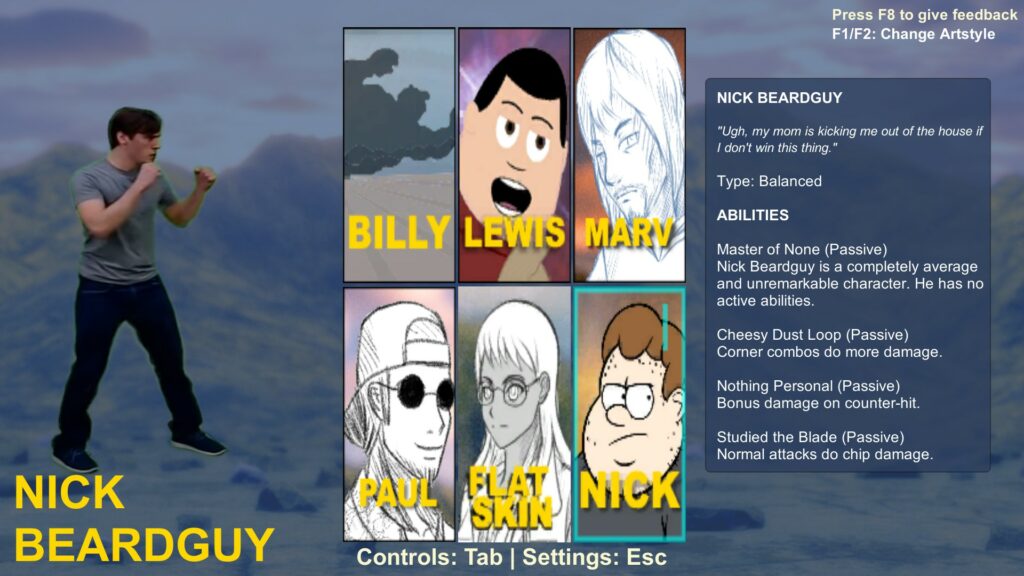
The graphics are still VERY much temporary placeholders, but you can start appreciating some interesting ideas, like having a character with no active special moves but several passive buffs.
A decent view on what’s to come
The alpha I have tested has a training mode, a local versus mode, a versus CPU mode, a classic arcade mode (albeit with no arcade endings yet), a survival mode and the Paul zone, that is, an infinite survival mode where your opponent is always Paul — I have no idea if this is an inside joke or anything, but I do think the idea is kind of hilarious.
A special mention goes to the difficulty options. Instead of tweaking the AI, the game gives you different amount of hints: at Easy, you will know the move inputted by the AI before choosing yours, effectively becoming a good tool to learn how to answer to different situations; at Normal, you will only see the direction the AI is inputting, but not the button. While this is already more than enough to reply to the AI, once you know the game a bit, it’s already a bit more challenging and good enough to refine your opponent reading abilities; at Hard, the game won’t give you any hint, you’ll need to guess like in a real encounter against a real person (except that against the AI you can definitely learn how to exploit its patterns). Overall it’s a very intelligent implementation, in terms of accessibility and teaching the player what to do and when.
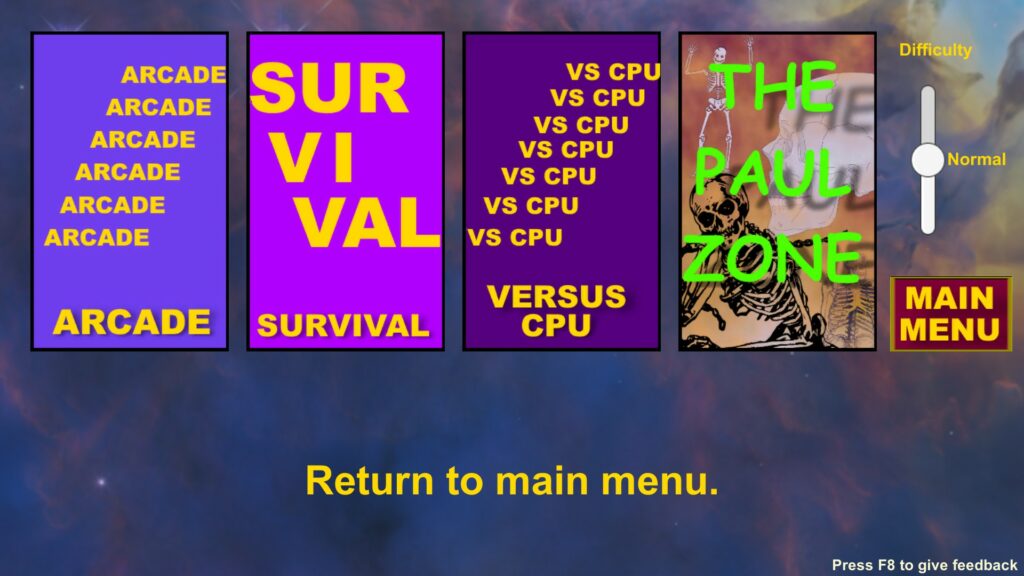
There is a decent amount of stuff to do in the alpha, to test out the system and play around. The difficulty selector is a highlight of intelligent accessible design.
How to play it?
Currently, the game is in a closed alpha state, but you can contact the developer Mega Memecast through their Twitter account or Discord server in case you are interested. Overall, if you are into fighting games and love reading your opponent more than pushing buttons, keep an eye on this game, because it might be something exactly done for you. Due to its turn based nature this is one of the few fighting games that wouldn’t significantly benefit from rollback netcode. Steam Remote Play, Parsec or traditional delay netcode would be more than enough to enjoy it and play it around the world with your friends on the other side of the pond!
Summary
Name: Mega Knockdown
Developer: Mega Memecast (official website, Discord server, Twitter account)
Available on: PC
Price: TBA
Year of release: TBA
Netcode: none (Steam remote play)
In one sentence: A true turn-based fighting game for mind game purists.
Special thanks to the developer Mega Memecast for providing me access to a preview build of this game. No Jerma were harmed in the process of writing this article.

